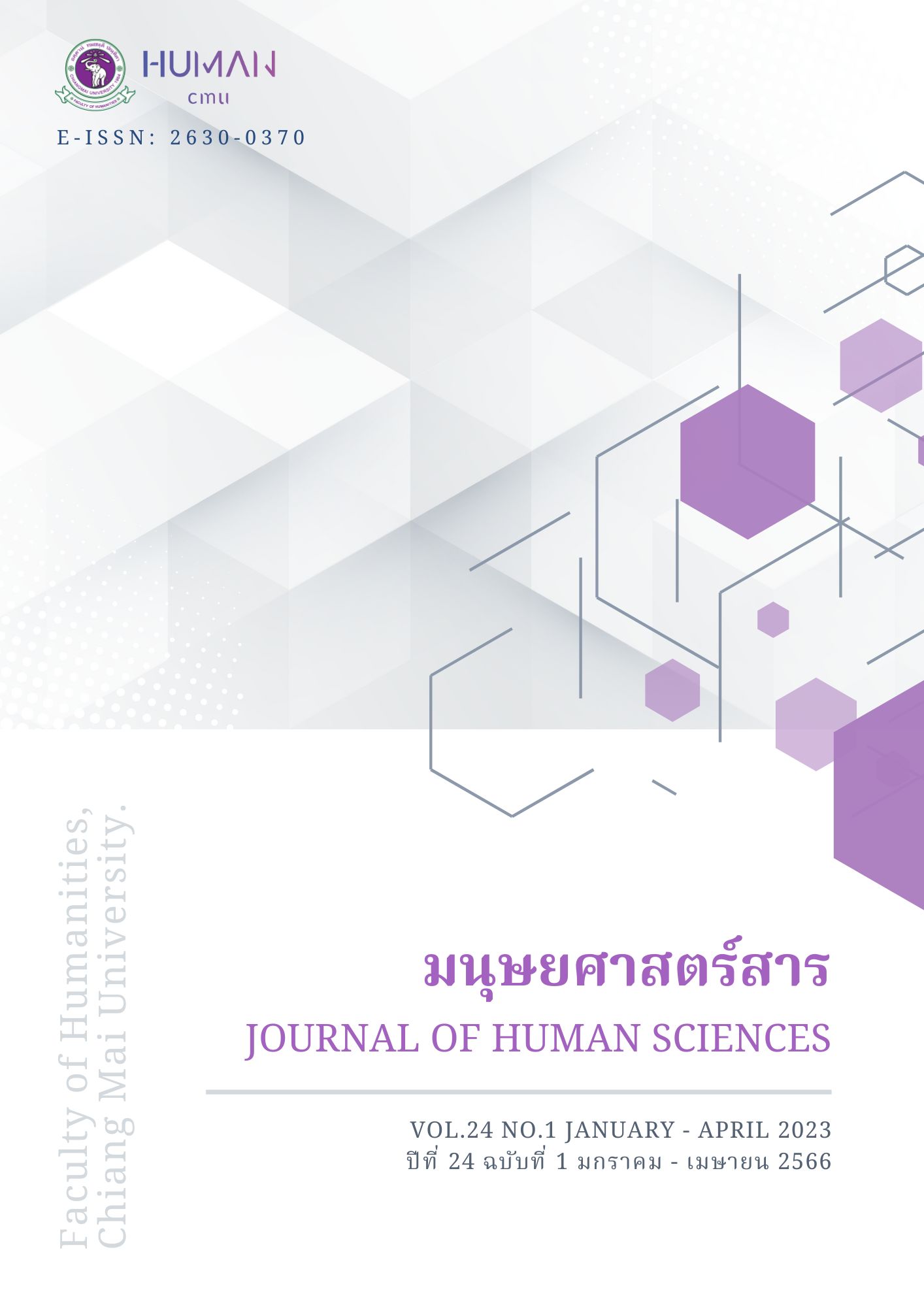เรื่องเล่าในรอยสัก : เรื่องราวชีวิตและการประกอบสร้างอัตลักษณ์
Main Article Content
บทคัดย่อ
การวิจัยครั้งนี้มีวัตถุประสงค์เพื่อศึกษาเรื่องราวในชีวิตที่สะท้อนผ่านรอยสัก และศึกษาการประกอบสร้างอัตลักษณ์ผ่านรอยสักของตัวบุคคล ซึ่งเป็นงานวิจัยเชิงคุณภาพ โดยใช้การวิเคราะห์เรื่องเล่าตามทฤษฎีและวิธีวิทยาของ McAdams (2006) ผู้ให้ข้อมูลมีจำนวนทั้งสิ้น 6 คน ผลการศึกษาแสดงให้เห็นข้อโต้แย้งหลัก คือ รอยสักไม่ได้เป็นเพียงแฟชั่นที่ผู้คนมีไว้ใช้เพื่อตกแต่งร่างกายเพียงเท่านั้น แต่รอยสักเป็นสัญลักษณ์ที่ผู้คนใช้แสดงให้เห็นถึงอัตลักษณ์ ตัวตน และเรื่องราวในชีวิต ข้อสนับสนุนข้อโต้แย้งหลักประกอบไปด้วยแก่นสาระ 3 ข้อ ได้แก่ 1) เรื่องเล่าของรอยสักในฐานะการแสดงออกถึงอัตลักษณ์ส่วนบุคคล 2) เรื่องเล่าของรอยสักในฐานะการต่อรอง ต่อต้านกับค่านิยมในสังคม และ 3) เรื่องเล่าของรอยสักในฐานะการเปลี่ยนผ่าน และการเยียวยาตนเอง
Article Details

อนุญาตภายใต้เงื่อนไข Creative Commons Attribution-NonCommercial-NoDerivatives 4.0 International License.
เอกสารอ้างอิง
ณฐมน แก้วพิทูล. (2563). การสื่อสารอัตลักษณ์ผ่านรอยสักของกล่มชายรักชายในจังหวัดเชียงราย.
วารสารการสื่อสารมหาวิทยาลัยราชภัฏเชียงราย, 3(2), 65-85. https://so01.tci-thaijo.org/index.php/CRRUJC/article/view/242015/166336
ทิพย์วิมล จรลี. (2558). บุคลิกภาพห้าองค์ประกอบ ความสามารถในการเผชิญและฟันฝ่าอุปสรรคและการ
รับรู้พฤติกรรมการเป็นสมาชิกที่ดีขององค์การของพนักงานกลุ่มบริษัทผลิตไฟฟ้าขนาดเล็กแห่ง
หนึ่ง. [วิทยานิพนธ์ปริญญามหาบัณฑิต, มหาวิทยาลัยธรรมศาสตร์].
ทำไมคนสักลายถึงถูกมองว่าไม่ดี. (1 มีนาคม 2564). Artic.in.th. https://article.in.th/tattoo-bad-people-66
นันท์นริน ทีฆวิวรรธน์. (2560). ความวิตกกังวลจากการพรากจากในเด็ก. วารสารพยาบาลศาสตร์และ
สุขภาพ, 40(2), 130-137. file:///C:/Users/Admin/Downloads/kanung,+Journal+editor,+10%20(1).pdf
พจมาน นิตย์ใหม่. (2550). รอยสัก:การสร้างอัตลักษณ์ที่ปรากฏบนเรือนร่างของตน. [วิทยานิพนธ์
ปริญญามหาบัณฑิต, มหาวิทยาลัยเชียงใหม่].
พิมพ์ชนก กลิ่นสุทโธ. (2554). การศึกษาอัตลักษณ์แห่งตนของวัยรุ่นที่ครอบครัวแตกแยก. [ปริญญา
นิพนธ์มหาบัณฑิต, มหาวิทยาลัยศรีนครินทรวิโรฒ].
สุธิดา แซ่อึ้ง. (2559). การสื่อสารความหมายผ่านรอยสักของวัยรุ่นไทย. [วิทยานิพนธ์ปริญญามหาบัณฑิต, ,
มหาวิทยาลัยกรุงเทพ].
สุภลัคน์ ลวดลาย. (28 พฤษจิกายน 2562). เมื่อลูกต้องเลือกทางเดินของชีวิต Part 2. True ปลูกปัญญา
https://www.trueplookpanya.com/knowledge/content/77060/-blog-per-.
หทัยรัตน์ มาประณีต. (2555). การสักจากความเชื่อของผู้ใหญ่สู่กระแสนิยมของเยาวชน. วารสารสังคมศาสตร์
มหาวิทยาลัยศรีนครินทรวิโรฒ. 15, 163-166. https://ejournals.swu.ac.th/index.php/JOS/article/view/2639/2651
อภิญญา เฟื่องฟูสกุล. (2559). อัตลักษณ์ Identity การทบทวนทฤษฎีและกรอบแนวคิด.
คณะกรรมการ สภาวิจัยแห่งชาติ สาขาสังคมวิทยา สำนักงานคณะกรรมการวิจัยแห่งชาติ.
อารียา คหะวงค์. (28 ธันวาคม 2564). การสักบริบทของความเชื่อสู่ความงามบนเรือนร่าง. ICASWU
http://ica.swu.ac.th/news/detail/2/151
Bhushan, N. J. (14 January 2019). Narrative psychology and individual’s personality. Medium
https://medium.com/@jhansibhushann/narrative-psychology-and-individuals-personality-65d2fe610430
Breems, M. (2021). Tattoos Tell Stories: Children’s Literature Tattoos as a Form of Life Narrative.
The European journal of life writing, 10, 6-23. file:///C:/Users/Admin/Downloads/pvanlangen,+Breems+Tattoos+Tell+Stories%20(1).pdf
Brockmeier, J., & Carbaugh, D. (Eds.) (2001). Narrative and identity: Studies in autobiography, self
and culture. John Benjamins Publishing Company.
Creswell, J. W., & Poth, C. N. (2018). Qualitative Inquiry and Research Design: Choosing Among Five Approaches. Sage Publications.
Crossley, M. (2000). Introducing to narrative psychology: Self, trauma, and the construction of meaning. Open University Press.
Lilgendahl, J. P. (2015). The dynamic role of identity processes in personality development:
Theories, patterns, and new directions. In K. C. McLean & M. Syed (Eds.), The Oxford handbook of identity development (pp. 490–507). Oxford University Press.
McAdams, D. P. (1993). The Stories We Live by: Personal Myths and the Making of the Self. New
York: William Morrow
McAdams, D. P., Reynolds, J., Lewis, M., Patten, A. H., & Bowman, P. J. (2001).
When bad things turn good and good things turn bad: Sequences of redemption
and contamination in life narrative and their relation to psychosocial adaptation in
midlife adults and in students. Personality and Social Psychology Bulletin, 27(4),
–485.
McAdams, D. P., & Pals, J. L. (2006). A New Big Five Fundamental Principles for an
Integrative Science of Personality. American Psychologist, 61(3), 204-217. http://people.wku.edu/richard.miller/new%20big%20five.pdf
Mun, J. M., Janigo, K. A., & Johnson, K. K. (2012). Tattoo and the self. Clothing and
Textiles Research Journal, 30(2), 134-148.
Nemoto, M. (2015). Story of Hiroshima: Life of an Atomic Bomb Survivor. Asia: Biographies and
Personal Stories, 20(2), 53-57. https://www.asianstudies.org/publications/eaa/archives/story-
of-hiroshima-life-of-an-atomic-bomb-survivor/
Pennebaker, J. W. (1997). Writing about emotional experiences as a therapeutic
process. Psychological science, 8(3), 162-166. http://www.gruberpeplab.com/teaching/psych3131_summer2015/documents/14.2_Pennebaker1997_Writingemotionalexperiences.pdf
Schiff, B. (2012). The Function of Narrative: Toward a Narrative Psychology of Meaning. Narrative
Work, 2(1), 33-47. file:///C:/Users/Admin/Downloads/administrator,+nw2_1art03%20(1).pdf
Shimalla, A. (2015). INKED: How Tattoos Tell Stories. [Unpublished doctoral dissertation].
Stetson University.
Smith, E. E. (12 January 2017). The two kinds of stories we tell about ourselves. IDEAS.TED.COM. https://ideas.ted.com/the-two-kinds-of-stories-we-tell-about-ourselves/


